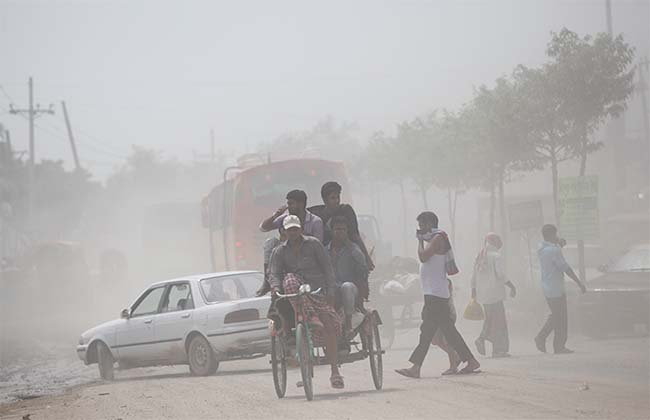
The air quality of Dhaka city has made a marked improvement by some 45pc on average a day during the first seven days of the Covid-19 lockdown due to the low level of emissions.
According to a survey conducted by Center for Atmospheric Pollution Studies (CAPS) of Stamford University Bangladesh, four reasons effectively worked behind the strange improvement in the air quality.
It said low traffic flow, suspension of road renovation and construction works and lack of activities to burn wastes led to the improvement in the air quality though it is said to be a short-lived gain.
Even the air pollution declined by 70pc in some areas in the city during the April 14-21 period, the survey says.
The survey was carried out under a project titled “Promoting Democratic Governance and Collective Advocacy for Environmental Protection in Dhaka City” with financial support from USAID and UKAid.
As part of the survey, the air quality was measured using automatic equipment for eight hours a day in 10 areas of the capital.
The measurement showed that the air quality has improved on average 45pc a day from April 14 to 21 last.
The average AQI score was 117.8 on April 14-21 during the full lockdown, which is 45pc less than the average score of 214.5 recorded on April 5-8 during the partial lockdown.
A significant improvement in the city’s air quality was also noticed in the beginning of the partial lockdown enforced on March 29 as the average AQI score was 168.3 from April 1 to 4 last. The air quality then worsened again as the restrictions on traffic and public activities were largely defied.
However, Dhaka’s air quality with a score of 117.8 was still ‘unhealthy’ for sensitive groups like children, pregnant women, elderly and people with heart and lung diseases as it falls into the AQI score 100-150 category, said CAPS founder director Prof Dr Ahmad Kamruzzaman Majumder.
During the April 5-8 last, the air quality with 214.5 was ‘very unhealthy’, he said, adding that the score 200-300 is considered as ‘very unhealthy’.
The air quality with AQI score 300+ is considered as ‘hazardous’ and the score 150-200 as ‘unhealthy’, said Prof Majumder, also the chairman of the Department of Environment Science of the university.
According to the study findings, suspension of digging, renovation and construction works of roads; non-movement of motorised vehicles; lack of pollution from waste burning; and the presence of less airborne dust contributed to the air quality improvement.
It says unsafe digging, renovation and construction works of roads are the source of 20pc-25pc of air pollution in Dhaka city. The capital has been in thick construction and reconstruction activities for decades affecting its air quality badly.
Black smoke emitted from some 5.6 lakh unfit vehicles is responsible for 15pc-20pc of air pollution in Dhaka. But movement of some 95pc unfit vehicles remained suspended during the lockdown (April 14-21).
Vehicular movement makes dust floating in the air from road-surfaces. But this airborne dust declined by 10pc due to the low traffic flow in the city. Burning wastages is responsible for 10pc of the city’s air pollution, which also was not seen during the lockdown.
During the 90 days from January to March 2021, the air quality was recorded as ‘hazardous’ for 12 days, ‘very unhealthy’ for 58 days, ‘unhealthy’ for 19 days and ‘unhealthy for sensitive groups’ for one day in Dhaka, one of the most polluted cities in the world, according to another recent study.
People are advised to avoid all outdoor exertion when the air quality is hazardous.
Dhaka that has long been grappling with poor air quality is frequently ranked the most polluted city, the second or third most polluted city in the world.
Dhaka’s air starts getting fresh with the advent of monsoon from mid-June and remains mostly acceptable till October.
Air pollution consistently ranks among the top risk factors for death and disability worldwide. Breathing polluted air has long been recognized as increasing a person’s chances of developing heart disease, chronic respiratory diseases, lung infections and cancer, according to several studies.
As per the World Health Organization (WHO), air pollution kills an estimated seven million people worldwide every year, largely as a result of increased mortality from stroke, heart disease, chronic obstructive pulmonary disease, lung cancer and acute respiratory infections.
